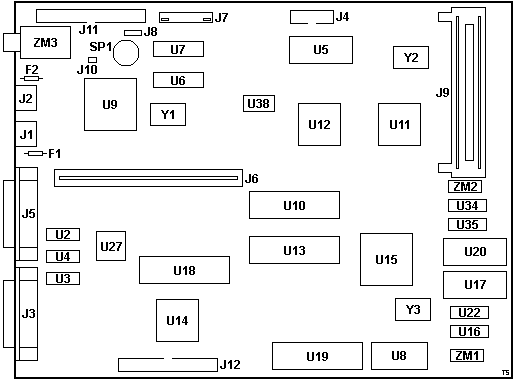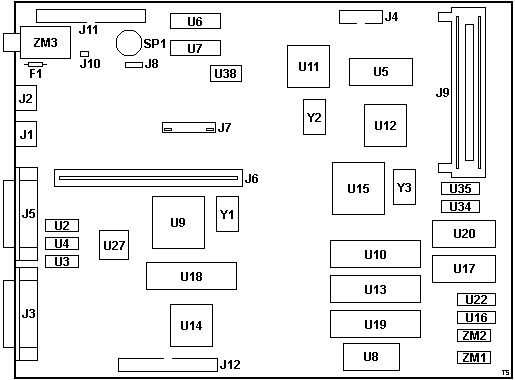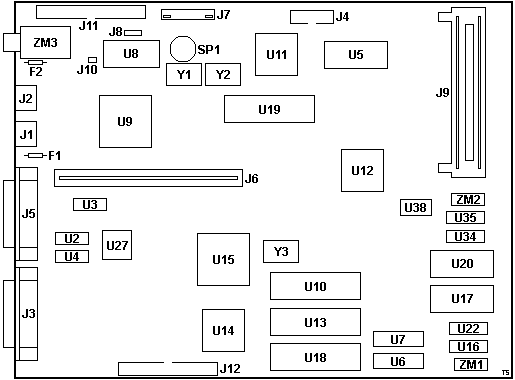|
25start.tg0 Model 25 Starter Disk v1.0 (zipped image)
adv25dia.exe Model 25 Advanced Diagnostics v1.00 (zipped image)
187-148 IBM 8525, PS/2 Model 25
187-149 PS/2 Model 25 Collegiate & Collegiate Kit
188-083 PS/2 Model 25 20MB Fixed Disk Drive and 20MB Fixed Disk Drive with adapter
189-145 IBM PS/2 Model 25 720KB 1-Inch High Diskette Drive Option
ISA Interrupt Sharing (PS/2 Model 25 & 30)
MCGA - Multi-Color Graphics Array
Specification
Model 25 Type 1 Planar
Model 25 Type 2 Planar
Model 25 Japanese Planar
System Firmware
ROM Images
Riser Card
Graphics Hardware
Upgrades
Floppy Drive
Known Problems
Based on content by William R. Walsh (original HERE). Edited by Major Tom.
Specification
8525-001 has a monochrome ("paper white") display and an 8086 CPU.
8525-004 is the same computing hardware as the 8525-001, only it
features a color display. I've seen far more of these with color
displays than monochrome ones, so I'm guessing monochrome wasn't as
popular of a choice. That seems odd, given the number of standalone
PS/2 monochrome monitors I have.
Model 25 Type 1 Planar P/N 00F2073
![Front [P]](/other/img/photo.gif)
![Back [P]](/other/img/photo.gif)

F1 Mouse fuse?
F2 Keyboard fuse?
J1 Mouse connector
J2 Keyboard connector
J3 Parallel port
J4 HDD15 video connector
J5 DB25 serial port
J6 Riser slot
J7 Power connector
J8 4-pin fan header (1 pin missing)
J9 Dual 30-pin SIMM socket
J10 2-pin keylock header
J11 44-pin HDD connector
J12 40-pin Floppy connector
SP1 Piezo speaker
U2,3 NS DS1489AN line revc.
U4 NS NS1488N line driver
U5 Inmos IMSG171P RAMDAC
U6,7 HM53461P 64Kx4 DRAM (MCGA)
U8 Intel P8253-5
|
U9 SLA6430J GA 72X8203
U10 Intel 8086-2 CPU @ 8 MHz
U11 SLA6430J GA 72X8300 MCGA Mem. Ctrl.
U12 SLA6330J GA 72X8205 MCGA Video Fmtr.
U13 Intel 8087 socket
U14 OKI/IBM 72X8206
U15 SLA6330J GA 72X8202
U16,22,34,35 NEC D4164C-10
U17 ROM BIOS
U18 NEC µPD765AC-2 FDC
U19 8237A DMA controller
U20 ROM BIOS
U27 NS8250AV UART
U38 Sony CXK5864BM-12L 8Kx8 SRAM (MCGA)
Y1 14.31818 MHz osc
Y2 25.175 MHz osc
Y3 48.0 MHz osc
ZM1,2 OKI MSM3764A-15 64Kx1 DRAM
ZM3 Earphone Connector
|
J8 4-pin header, 3-pins present. (external speaker?)
Note: Despite the drastically different PCB
layouts, the reference designators are largely consistent across all 8086-based
Model 25 and Model 30 planars.
Model 25 Type 2 Planar FRU P/N 96F7390, P/N 64F0738
![Front [P]](/other/img/photo.gif)
![Back [P]](/other/img/photo.gif)

Different PCB layout, but the component references and types are the same
as on the Type 1 Planar above, except for the
following items:
F1 Combined KB/Mouse fuse (F2 not present)
This planar is also used in the IBM 7690 Clinical Workstation.
Model 25 Japanese Planar "IGH0160DAM", P/N 78X8943
![Front [P]](/other/img/photo.gif)

Different PCB layout, but the component references and types are the same
as on the Type 1 Planar above.
This planar is not listed in the TR/HMM (at least not in the available
editions).
Japanese design, manufactured by Panasonic/Matsushita.
System Firmware (POST & BIOS)
Firmware stored in EPROM.
ROM Images
00F2092 / 00F2093 - 26 Jun 1987, rev. 0, 2x 27256 (U17 / U22), typically on Type 1 planar
00F2122 / 00F2123 - 26 Jun 1987, rev. 0, 2x 27256 (U17 / U22), typically on Type 2 planar
Riser Card
![Risers [P]](/other/img/photo.gif)
![Risers Front [P]](/other/img/photo.gif)
![Risers Back [P]](/other/img/photo.gif)

Two 8-bit ISA slots. No other components on the riser, aside from a resistor pack.
DIP Memory
I've been told that the 4xNEC D4164 are actually the 256KB upgrade that
serve to give you a full 640KB of installed RAM. The SIMMs seemingly provide
the base memory. (I'm not real sure I agree with that, since the SIMMs would be
so much easier to install for an end user.)
Graphics Hardware
The 8086 variant of the Model 25 has MCGA graphics
hardware, wired to work with an analog VGA monitor. MCGA is a curious
mixture of different technologies: in addition to all modes supported
by a CGA adapter, it supports the low resolution (320x240) 256 color
VGA mode and high resolution (640x480) monochrome VGA. However, EGA
display modes are not supported.
All other PS/2 Models having a 286 microprocessor (or better) have VGA
graphics hardware at a minimum.
More info about MCGA HERE.
Upgrades
I'm not aware of any for the CPU, short of replacing the
entire system board. As far as storage goes, something like an XT-IDE
board is probably your best bet. Older IDE and SCSI controllers have
their own expansion ROM on board may also work. A standard power
connector for a hard disk isn't available, though you can add one.
(Use the instructions for the 25SX/30-286/55SX ... the Model 25 8086
does NOT use the same power connector as the Model 30 8086!)
There are two internal expansion slots, both of which are 8-bit ISA types.
Memory expansion is limited to boards that provide additional RAM in compliance with the expanded memory specification (EMS).
Floppy Drive
Floppy drives are the bane of a PS/2 collector's existence. Pretty much
all of them still in existence today will require repair before they
are usable. At a minimum, you'll need to clean the dust and any foreign
objects out of the drive. You might as well plan on replacing every one
of the surface mounted electrolytic capacitors on the drive's circuit
board, and almost certainly cleaning up the corrosive mess left behind.
Although IBM never sold them configured as such, the 8086 version of the
PS/2 Model 25 has undocumented high density diskette drive (1.44MB)
support. Not all disk drives will work: only the drives manufactured by
Sony seem likely to work correctly. Other drives will only be "seen" as
a low density type or may not work at all. The floppy drive controller is
an NEC 765 or Intel 8272, both of which support high density diskettes,
and the BIOS obviously has some support as well. Whichever planar you have
in your Model 25 8086 also factors in -- later models are more flexible in
regards to which diskette drives will actually work. (The same is true
of the PS/2 Model 30.)
Known Problems
Erroneous/False Display Characters (ECA 023)
|